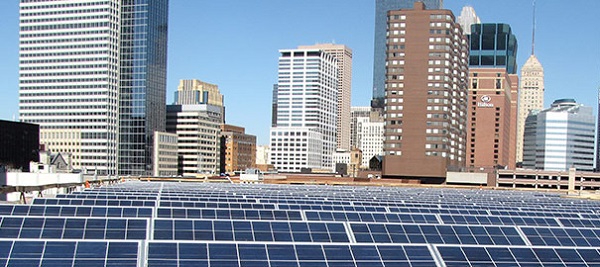By 2020, 1.5 percent of the energy that public utilities in Minnesota generate will have to come from solar. It’s estimated that this new requirement, signed into law last week by Gov. Mark Dayton, will result in a 32-fold increase in solar capacity in the state, up to 450 megawatts.
And that’s just one new law among many that should accelerate the turn toward clean energy and greater energy efficiency in Minnesota.

The advocacy group Fresh Energy noted that wind and flexible financing options that allow more Minnesotans to access solar projects got “short shrift” from St. Paul lawmakers, and pointed out that the legislative victories it did win won’t benefit customers of cooperative and municipal utilities.
Still, it said, the “bills passed into law were a good first step in answering Governor Mark Dayton’s call to transition to a cleaner energy future that creates thousands of jobs for Minnesotans.”
The big item, as mentioned, is the 1.5 percent solar requirement, which requires that solar be part of the renewable energy portfolios for companies like Alliant Energy, Xcel Energy, Minnesota Power and Ottertail Power. The state already has a 25 percent-by-2025 renewables mandate, which has helped to bring lots of wind online. (Minnesota got 14.3 percent of its electricity from wind power in 2012, fourth-best in the nation, according to industry data).
The law requires that at least 10 percent of the new solar capacity come from systems under 20 kilowatts in size (for reference, the average residential system is 4-6 kW). According to Midwest Energy News, the legislature also is keeping in place through 2018 a Solar Rebates program, valued at $5 million a year. But instead of paying an upfront rebate, it’s been tightened up a bit to pay based on actual production.
A couple other pro-clean energy Minnesota that Fresh Energy pointed out:
- Net Metering: While opponents were out to trim back net metering in Minnesota, Fresh Energy says it and its allies were able to fight back that effort and get a “new law passed that expands the size of projects that qualify for net metering from 40 kilowatts to 1,000 kilowatts” (this was a significant limitation). Other changes in the law will also encourage “large commercial and industrial customers to meet their electricity needs with onsite renewable energy generation,” the group said.
- Community Solar: We’ve seen community solar growing in a big way, particularly in Colorado. Minnesota is now on the path to do similar things, with new legislation that sets in motion the development of “solar gardens” that allow customers – renters, homeowners who have a shaded roof, etc. – to go in together to develop a solar power array and share in its benefits.